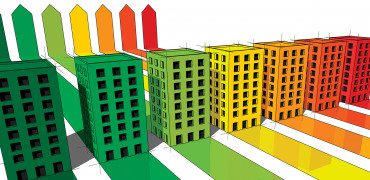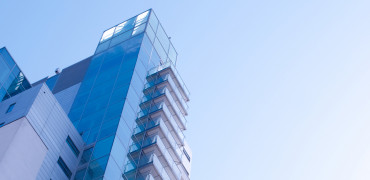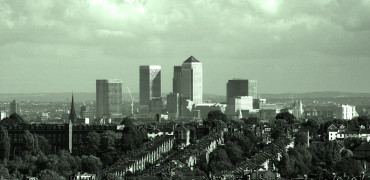It shocks me how quickly a decade has gone, which may just be a sign of me aging, but it is now 10 years since we created our Green Gateway initiative as a way of trying to focus the attention of all those involved in the construction industry – from initial design, installation, commissioning, operating and removal, on the need for change and the things we can do both individually and collectively to make a difference.
When we first launched the initiative, at the RAC Show in 2007, the industry focused most attention on the fact that part of the initiative was the declaration that we as a manufacturer would not promote air conditioning to the residential market as it is simply not necessary in the vast majority of existing UK homes (which simply need better ventilation when we have a heatwave).
What we also did though with Green Gateway was build detailed arguments for the use of heat pumps for heating over fossil fuels and highlighted how these arguments were strengthened as the overall energy grid got greener.
The central thrust of Green Gateway focuses on the need for all of our buildings to become better users of energy, with the right equipment to efficiently heat, cool and ventilate them to suit the time, weather and usage at any given time.
And the need to achieve this is still a discussion we are having with our partners, customers and their customers today, so what, if anything has changed in the past ten years? And what are the important issues that still need addressing?
Climbing the news agenda
In 2006, former US Vice President Al Gore launched his documentary film ‘An Inconvenient Truth’ and used his fame to help seriously raise the issue of climate change in the public consciousness.
During the past decade, we have seen the overwhelming body of scientific expertise align with the central, scary premise of the movie … that climate change is real, is happening, and mankind and its unchecked activities are impacting negatively on our planet.
Despite the current incumbent in the White House and his recent decision to pull out of the Paris Agreement on Climate Change, there are few climate sceptics who are really taken seriously these days and, as my colleague Russell Jones highlights here, many industries, politicians and states in the US are ignoring the President’s actions and looking at what they can do to mitigate the effects of climate change.
Weather or not?
One thing you cannot fail to have noticed over the last decade, no matter where in the world you live, is the impact climate change is having on weather patterns.
We know that there are always variants in weather patterns, such as El Nino which can dramatically affect ocean currents across the Atlantic and bring harsh or wet winters to Britain every 5-10 years.
This is different though. Climate change has had a recorded impact on sea levels and also sea temperatures and, as the recent devastating events in the Americas and Caribbean have shown, this can make any normally occurring weather events such as hurricanes much, much worse.
This animation shows the extent of global warming in just 26 seconds.
Here in the UK, we’ve also seen lots of flooding and whilst this has rightly focused attention on how and where we build (try avoiding the floodplains please!) and how we mitigate the effects of these new homes, communities and infrastructures, it has also called into question general agricultural policy across the country.
Farmers and landholders are now being questioned on how they manage their land and encouraged to plant on hills, rather than clear them, so the trees can act as a water trap, with additional plans for fields to be ready and on stand-by for any flooding, to avoid homes and businesses suffering.
Energy using equipment
As a manufacturer of the equipment that heats, cools and ventilates the spaces we all work, rest and play in, you would expect me to focus on this and the good news to report is that over the past decade, this equipment has in the main got smaller, quieter and more efficient, able to generate more of the heat, cool or air that we want, whilst using less energy and less material resource.
This is likely to continue, especially as our urban areas get denser with more buildings, and more mixed-use buildings, in close proximity to each other.
And this is one of the central themes of Green Gateway – smaller equipment with better control.
With modern life, you have to have some way of regulating and controlling the temperature within our buildings. There is just too much heat-generating equipment in modern life, whether that is office computers, photocopiers, etc, or all the ‘essential’ gadgets that we all must have in our homes!
What we have long advocated is planning and preparing a building properly in the first place, whether that is a new-build or refurbished, so that you minimise the amount of energy you will need to use to heat, cool or ventilate the spaces within. We call this ‘Doing the Right thing’.
Then make sure you specify the right equipment at the right size to suit the purpose and space.
Then, make absolutely sure you have the right control system in place so that it can automate as much as possible and provide the monitoring and reporting necessary to highlight when any manual intervention may be needed.
Green is good
Probably the most encouraging thing to have happened in the past 10 years is the greening of the grid, with gas and coal power generation now going into serious decline. In fact in April, we saw the first day since 1882 when the country generated a whole day of electricity without needing to use coal-fired power stations.
Not only is this going to help reduce the effect of climate change, it is also making the case against gas and oil heating for our buildings.
When you can use a heat pump to convert every kilowatt of electricity consumed into 3, 4, 5 or more kilowatts of heat energy for a building, why would you still want to burn one kilowatt of gas or oil to produce less than one kilowatt of heat energy?
This does not make sense anymore and as overall power production moves to wind, tidal, Photovoltaic and other renewables, along with nuclear, then the case for using electric heating becomes even more viable.
And don’t forget that modern air conditioning systems are also advanced ‘heat pumps’ which can take heat generated in one area, say a kitchen or IT Server room, and reuse it elsewhere in a building to heat offices or even the water for bathrooms and kitchens.
Conclusion
The 10th anniversary of our Green Gateway initiative has been a useful exercise in reviewing just how far we’ve come in the last decade, and whilst we all know that there is still a long way to go before we can be sure we have stopped damaging our only planet, I have been encouraged by how much awareness has been raised.
I’ve also not touched on legislation and what Governments are trying to do to help drive the system, whether collectively with the Paris Agreement, or individually, with the recent RHI announcements.
If I can end on Al Gore once more, I’ve been encouraged by the release of his latest climate change film ‘An Inconvenient Sequel: Truth to Power’ where he still highlights how much of an issue there is and how scary it remains, but also points to the ingenuity of humanity to fix things and come up with the solution.
We have shown we can do it as the repairing of the hole in the ozone layer has shown. 10 years on from the launch of our Green Gateway, I’m confident that the construction industry also has the tools, skills and equipment that can help to make a difference.
Martin Fahey is Head of Sustainability & Commercial Business at Mitsubishi Electric and coordinator of the company’s Green Gateway programme.
If you have any questions about this article, you can contact us via email. Or if you would like to tweet us, please follow our MEUK_LES twitter page.
We upload new articles every week so remember to check back regularly.
You can also sign up for our monthly newsletter below.


